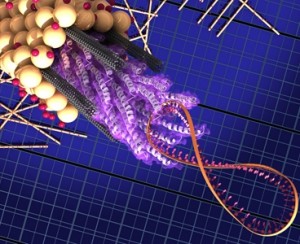
Graduate students Xiangnan Dang and Hyunjung Yi found that a genetically modified version of M13 can be used to control the nanotubes on a surface, keeping the tubes separate so they can’t short out the circuits, and keeping the tubes apart so they don’t clump.
The research was published online in the journal Nature Nanotechnology. It is based on findings that carbon nanotubes can enhance the efficiency of electron collection from a solar cell’s surface.
But nanotubes present problems of their own because their manufacturing usually produces a mix of two types: semiconductors or metals, which have an impact on how electric current flows. The research shows that semiconductors can enhance the performance of solar cells, while metals do the opposite.
Nanotubes do tend to clump together, though, and that’s where the virus can help. It can be used to control the arrangement of the nanotubes on a surface, keeping the tubes separate so they don’t do what they shouldn’t be doing, that is, shorting out the circuits and clumping.
Using dye-sensitized solar cells for tests, the researchers found that structures built with the virus enhanced conversion efficiency from eight to 10.8 per cent, although the viruses and the nanotubes only accounted for 0.1 per cent of the finished cell weight. The researchers believe even better results are possible.
Besides, the viruses make the nanotubes soluble in water, making it possible to incorporate the nanotubes into the solar cell using a water-based process that works at room temperature.
Apart from better conversion rates, the one-step process could be added to existing solar-sell manufacturing facilities.
Follow the link to get further information about the technical details of the research on M13.
Follow us on @energyrefuge





